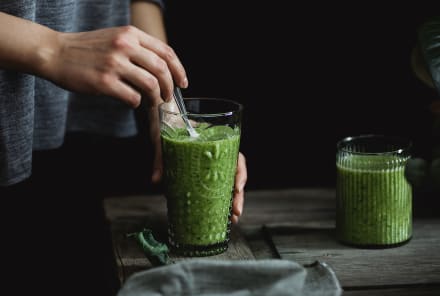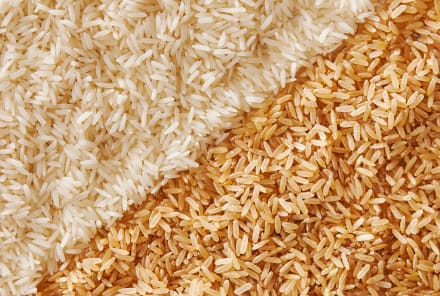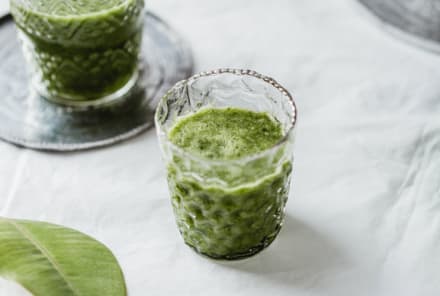Advertisement
Ayurvedic Diet 101: Principles, Food Rules & How To Eat For Your Dosha

The term Ayurveda translates to "the science of life." That is exactly what Ayurveda is: the science of preserving and nourishing the human body, as enumerated in India about 5,000 years ago. It is also the only way I know how to live. I was raised in a joint family of 14 members with the principles of Ayurveda, as taught by my grandfather, an Ayurvedic healer in Mumbai, India.
I carry this generational wisdom and his legacy to the West to share this incredible science in a comprehensible yet undiluted manner. My formal Ayurvedic education has been in Sanskrit, which allows me to minimize what's usually lost in translation.
A common misconception is that an Ayurvedic diet comprises specific food items, either kitchari or something Indian, loaded with some ghee and pungent spices. But that is far from what the diet really is.
Here are the true essential principles of the Ayurvedic diet, with foods to eat and avoid and a sample meal plan for each dosha.
What is the Ayurvedic diet?
The Ayurvedic diet is based on principles rather than prescriptions. It is a set of guidelines that honors the environment of the gut, bio-individuality, circadian rhythms, personal taste preferences, and our capability to extract nutrients from food as humans.
What are the benefits?
The Ayurvedic diet is simple yet powerful. I have seen people who test the Ayurvedic way of consumption for even a few weeks enjoy improved digestive symptoms, sleep, and overall health.
While scientific literature on the diet as a whole is limited, the following benefits have also been supported by research:
- Better immune function1
- Increased satiation and weight loss2
- IBS management3
- Possibly reduce the risk of chronic diseases like diabetes4 and hypertension5 (when combined with other Ayurvedic principles)
The principles of the Ayurvedic diet.
Ordinarily, we would assume that the most important function of food is to nourish our body and provide us with nutrients. However, according to Ayurvedic wisdom, it is paramount for the diet to maintain and enhance the gut's environment (agni), even before it nourishes.
If a food is considered high in its nutritional value but can create dysfunction in the gut, it will eventually hurt digestion and, thus, the ability to take the best out of all subsequent foods. After all, you are not what you eat. You are only what you can digest.
You are not what you eat. You are only what you can digest.
Below are some essential principles of the Ayurvedic diet that help to maintain Agni (the digestive fire) as well as nourish the body:
Balance the six tastes.
A meal should consist of all six tastes: sweet, sour, salty, bitter, pungent, and astringent.
The struggle to maintain the balance of protein, fat, and carbohydrate intake is not Ayurveda's idea of balance. Instead, the inclusion of all six tastes makes meals appetizing and balanced in Ayurveda.
When all six tastes are combined in a meal, digestion, absorption, nourishment, and elimination are optimized.
Beyond that, the taste also tells you how a certain food may act in your body, making you your own health expert.
Madhura / Sweet Taste:
I don't mean sweet like processed treats, but foods that carry an inherent sweetness and moisture within them, like rice, ghee, milk, etc. These foods can be generally heavy but are essential for the diet since they serve as raw material for new cells in the body. They are building blocks. Example foods include:
- Moist grains
- Healthy fats
- Fleshy sweet veggies
- Root vegetables
Amla / Sour Taste:
Just the thought of something sour can make one salivate. That is exactly what sour foods do; release digestive enzymes and build an appetite. Additionally, sour foods are inherently warming (think of how sour would burn a raw bruise on the skin) and support the breakdown of other foods. Example foods include:
- Lemon/Lime
- Garcinia Cambogia
- Pickled ginger
- Tamarind
- Amla juice
- Pomegranate seeds
Lavana / Salty Taste:
Salt also has the power to support the breakdown of foods (think of how it melts the snow on the roads). It has a scraping effect and prevents foods from sticking to the digestive lining, according to Ayurvedic principles. However, excessive salt can interfere with the body's water content. Ayurveda recommends Himalayan salt as its negative effects are thought to be milder. Example foods include:
Katu / Pungent Taste:
By their very taste, pungent foods are warming and should be consumed in small quantities to support the breakdown of other foods, especially sweet-tasting foods. Spices are the most recommended pungent foods. Excessive pungent foods eaten without other balancing tastes can damage the mucosal lining. This is the reason that turmeric is traditionally never consumed by itself. Example foods include:
- Spices
- Ginger
- Cloves
- Mustard seeds
- Hing/Asafoetida
- Peppers
- Parsley
- Daikon
Tikta / Bitter Taste:
Taste something bitter, and your mouth will dry up quickly. Digestion can be an aggressive and slimy process. Bitter foods cool everything down and dry up excessive slime, bringing the gut back to equilibrium. Example foods include:
- Kale
- Curry leaves
- Arugula
- Dandelion greens
- Spinach
- Bitter melon
- Fenugreek leaves
- Broccoli raab
- Chard
Kashaya / Astringent Taste:
These dry and earthy foods help bind other foods, allowing waste to take its solid form. Certain astringent foods also dry up digestive enzymes and serve as a signal to stop eating. Astringent foods should always be consumed with other tastes to prevent them from drying out the mucosal lining. Example foods include:
- Green plantain
- Lentils
- Beans
- Chickpeas
- Buttermilk
- Turmeric
- Cruciferous vegetables
While it may not be possible to include all six tastes at every meal, it is essential to incorporate them during your main meals and be generally mindful about using tastes that support each other.
Eat warm foods.
Everywhere in the universe—whether it is cooking, photosynthesis, or digestion—transformation requires heat. The digestive environment (agni), therefore, is a warm environment that supports the breakdown of foods. Protecting agni is protecting life, and cold foods and liquids can dwindle this agni. To keep the agni active, all foods should be consumed warm.
Cook your food.
Ayurveda advocates consuming only cooked foods. Raw foods require a more significant breakdown process, increasing the load on the agni. This is thought to create dysfunction in the gut over the long term. Fruits are an exception to this rule as they are precooked by the sun.
Eat fresh foods.
While a "farm-to-table" approach is highly recommended, it is not always possible in this era. The second best option is "stove-to-table." Foods are best consumed within 48 minutes of being cooked, after which they begin to break down rapidly, leading to an underlying fermentation process. Once kept overnight, they are considered stale.
Similarly, refrigeration of cooked foods, especially overnight, is not recommended. In Ayurveda, refrigeration destroys the prana (life force) in food, making it less supportive.
Align your meals with your circadian rhythm.
As diurnal mammals, our agni takes strong cues from the sun. The same meal, when consumed at lunch, will break down differently compared to dinner.
As the sun rises in the morning, so does our agni, making it a good time for a light breakfast. During midday, the sun and the agni both peak, signaling that lunch should be the heaviest meal of the day. As the sun sets in the evening, the agni begins to dwindle rapidly. Dinner is therefore meant to be the simplest and lightest meal of the day.
Use spices and good fats to stimulate digestion.
Agni is not like the dry fire on a matchstick that quickly burns but rather the flame on an oil lamp that uses fuel to regulate itself. To support the agni, each meal should ideally contain a spice (the warmth) and a healthy fat (the fuel). Ayurveda's go-to good fat is ghee, and spices can range from more pungent spices like ginger and black pepper to sweeter ones like fennel, cinnamon, and cardamom.
Eat with your mind and body engrossed in the meal.
Ayurveda advocates that one must not only consume for their body but also engage their mind during consumption. Your body takes cues from the nervous system to determine the release of neurotransmitters and enzymes. If you see a tiger, the body will receive the cue to run and release glucose and adrenaline.
Similarly, when the focus is on consumption and digestion, digestive enzymes will be released and function at their best.
Tweaking your foods for your dosha.
While the goal is to keep the body and gut environment regulated for optimum health, the body can carry inherent doshic tendencies that take it away from equilibrium. According to Ayurveda, doshas are bodily functions that support the body when they are in balance and destroy homeostasis when not. There are three primary doshas. (This quiz can help you uncover yours.)
Kapha: The building dosha.
Everything that supports building and preservation in the body is a kapha function. Kapha elements in the body are generally heavy and, when present in excess, can slow down the body, lower agni, build extra tissue, and make one lethargic. Kapha dominance needs warm, stimulating, and light foods to remain in balance.
Agni: Slow
General challenges: Sluggishness, weight gain, lethargy
How to eat:
- Scan your food and think about portions beforehand
- Be mindful of portion size
- Never lie down right after eating
What to eat: Warm and well-spiced foods. Lighter foods like millet, oatmeal, barley, and leafy greens.
Avoid eating: Too many fruits, smoothies, shakes, or dairy. Avoid cold food and excessive fats.
Tips & tricks for kaphas:
Pitta: The transforming dosha.
Everything that supports metabolism and transformation in the body is a pitta function. Pitta elements, like digestive enzymes in the body, are generally warm and, when present in excess, can aggravate agni, burn out digestion, give rise to acidity, cause loose burning stools, and more. Pitta dominance needs sweet and inherently cooling foods to remain in balance.
Agni: Sharp
General challenges: Acidity, intolerance to the sun, rashes, boils, anger
How to eat:
- Make sure your body has cooled down before eating
- Wash your face and hands with cool water before you start to eat
- Play soft instrumental music
- Use floral aromas when possible
What to eat: Cooling foods like ghee, rice, coconuts, and almonds.
Avoid eating: Spicy, fried, fermented, stale food, and junk foods.
Tips & tricks for pittas:
Vata: The dosha that moves and eliminates.
That which supports all movement and elimination in the body is governed by vata dosha. Vata should function like a gentle wind, propelling all movement and drying as well as pushing waste out of the body. When in excess, it can act like an aggressive wind, creating bloating, dryness, anxiety, and malabsorption of food. Vata dominance needs warm, moist, and grounding foods to remain regulated.
Agni: Volatile
General challenges: Dryness, bloating, gas, anxiety, constipation, sleeplessness
How to eat:
- Take a few deep breaths before eating
- Eat crossed-legged when possible
- Eat slowly without talking or opening the mouth too much
- Eat with complete focus and attention toward your meal
What to eat: Satisfying warm cooked, well-spiced foods that are not too heavy and made with good fats.
Avoid eating: Raw, very light foods, or diet foods like popcorn. Avoid fasting.
Tips & tricks for vatas:
Sample Ayurvedic menu.
Breakfast:
Timing: Between 8 and 10:30 a.m. (after exercise)
Principle: Warm, light & spiced
Options:
- Oatmeal with coconut oil and cinnamon
- Spiced cup of warm milk
- Corn polenta with spices
- Stewed apples with cinnamon
- Roasted sweet potatoes with black pepper
Kapha modifications: Add more spices and reduce quantities.
Pitta modifications: Double down on good fat and reduce spices.
Vata modifications: Chew slowly, and include a moderate quantity of ghee and spices.
Lunch:
Timing: Between 12 and 2:30 p.m. (largest meal of the day)
Principle: All six tastes
Options:
- Veggie bowl with all six tastes
- Chili with a side of tortilla and veggies
- Mujadara with a side of hummus and vegetables
- Fried rice with vegetables in black bean sauce
- Sushi with ginger and wasabi and a side of miso soup
Kapha modifications: Reduce quantities and walk 100 to 200 steps after eating.
Pitta modifications: Sit in a cool place and make sure you include plenty of good fats.
Vata modifications: Sit quietly without distraction. Drink ginger tea with meals.
Dinner:
Timing: Before 6:30 p.m. (should be around half the quantity of lunch)
Principle: Keep it simple
Options:
- Warm soup or stew
- Roasted vegetables with herbs and spices
- Kitchari
- Rice-based dish
Kapha modifications: Choose soup over anything.
Pitta modifications: Avoid all spicy foods at this hour. If not hungry, skip dinner and drink a cup of warm milk with licorice or cardamom.
Vata modifications: Eat a moderate amount. Sit cross-legged if you can.
The takeaway.
Ayurvedic food principles are time-tested and logical. Ayurveda enables one to move away from health-related fear and toward freedom and empowerment. When understood correctly, it is not a way of living that puts you in a box but rather one that sets you free.
Watch Next
Enjoy some of our favorite clips from classes
Enjoy some of our favorite clips from classes
What Is Meditation?
Mindfulness/Spirituality | Light Watkins
Box Breathing
Mindfulness/Spirituality | Gwen Dittmar
What Breathwork Can Address
Mindfulness/Spirituality | Gwen Dittmar
The 8 Limbs of Yoga - What is Asana?
Yoga | Caley Alyssa
Two Standing Postures to Open Up Tight Hips
Yoga | Caley Alyssa
How Plants Can Optimize Athletic Performance
Nutrition | Rich Roll
What to Eat Before a Workout
Nutrition | Rich Roll
How Ayurveda Helps Us Navigate Modern Life
Nutrition | Sahara Rose
Messages About Love & Relationships
Love & Relationships | Esther Perel
Love Languages
Love & Relationships | Esther Perel












